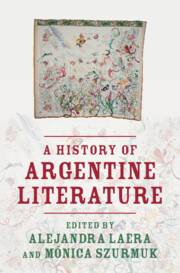Book contents
- A History of Argentine Literature
- A History of Argentine Literature
- Copyright page
- Contents
- Figures
- Contributors
- Editors’ Acknowledgments
- Introduction
- Part I Literary Dates
- Part II Critical Inroads
- Chapter 11 Print Culture in the Nineteenth Century
- Chapter 12 Criollismo: Gauchos in Literature and Film
- Chapter 13 Race and Nation
- Chapter 14 Science in Argentine Literature
- Chapter 15 Essay and Territory: The Geography of National Identity
- Chapter 16 Music as Sonic Literature
- Chapter 17 The Jewish Presence in Argentine Literature
- Chapter 18 Emancipation: Twentieth-Century Female Writers, Journalists, and Activists
- Chapter 19 Forsaking Tradition: Dislocating the Sovereignty of Argentine Literature
- Chapter 20 Mujeres raras: Patriarchal Nightmares, Dissident Imagination
- Part III Literary Names
- Index
- References
Chapter 13 - Race and Nation
from Part II - Critical Inroads
Published online by Cambridge University Press: 09 May 2024
- A History of Argentine Literature
- A History of Argentine Literature
- Copyright page
- Contents
- Figures
- Contributors
- Editors’ Acknowledgments
- Introduction
- Part I Literary Dates
- Part II Critical Inroads
- Chapter 11 Print Culture in the Nineteenth Century
- Chapter 12 Criollismo: Gauchos in Literature and Film
- Chapter 13 Race and Nation
- Chapter 14 Science in Argentine Literature
- Chapter 15 Essay and Territory: The Geography of National Identity
- Chapter 16 Music as Sonic Literature
- Chapter 17 The Jewish Presence in Argentine Literature
- Chapter 18 Emancipation: Twentieth-Century Female Writers, Journalists, and Activists
- Chapter 19 Forsaking Tradition: Dislocating the Sovereignty of Argentine Literature
- Chapter 20 Mujeres raras: Patriarchal Nightmares, Dissident Imagination
- Part III Literary Names
- Index
- References
Summary
The myth of Argentina as a uniquely white European nation dominated throughout the twentieth century. This myth gave rise to the belief that race and racism do not exist in and are irrelevant to Argentina. The literary canon not only reflected these dominant narratives but played an instrumental role in their construction and dissemination. Early canonical works lay the groundwork for Argentina’s long-running fictions of extermination, insisting on the physical disappearance of nonwhites while redefining “negro” as an implicitly dark-skinned symbol of the politically dangerous masses. Rewritings and parodies of these fictions have abounded in Argentine literature from the nineteenth century to the present. Contrary to the widespread insistence that race and racism are extraneous to Argentina, these works show that race and the trope of racialized class struggle – in which the survival of one hinges on the elimination of the other – have been a central concern in Argentine literary and national imaginaries. Meanwhile the unquestioned assumption of racelessness forged a critical silence and blindness that did not comply to the notion of whiteness. Recently, however, literary works and criticism have begun to pose a significant challenge to narratives of white Argentina.
- Type
- Chapter
- Information
- A History of Argentine Literature , pp. 201 - 215Publisher: Cambridge University PressPrint publication year: 2024



